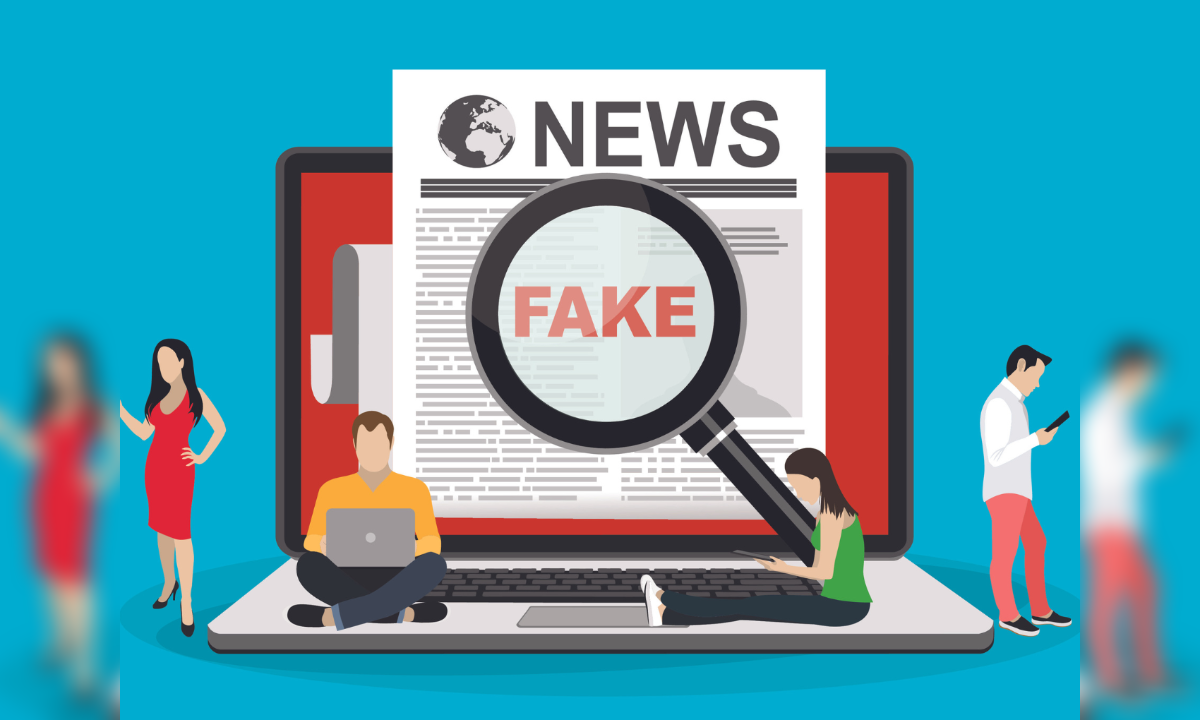A study by MIT researchers found that false news travels faster and farther than true news, particularly on social media platforms. The study attributed this to the novelty and emotional nature of fake news,

The digital revolution has democratized access to information like never before. Yet, this very openness has fostered a dark side: the Disinformation Age. Characterized by the rampant spread of “fake news,” the rise of echo chambers, and a subsequent erosion of trust in institutions, this age poses a significant threat to informed discourse and democratic processes. This article delves into these phenomena, examining their origins, consequences, and potential solutions.
Deluge of Disinformation: Fake News and its Allure
The term “fake news” encompasses a broad spectrum of misleading information, ranging from fabricated stories to misleading headlines and biased reporting. Unlike traditional media, where gatekeepers vet information for accuracy, the digital landscape allows anyone to publish content with minimal barriers. This ease of dissemination fuels the spread of sensationalized and often demonstrably false narratives, designed to exploit emotional triggers and confirmation bias.
The allure of fake news stems from several factors. Firstly, it often aligns with pre-existing beliefs and reinforces existing biases, providing a sense of validation for its consumers. People are more likely to believe information that confirms their worldview, even if it’s demonstrably false. This phenomenon, known as confirmation bias, plays a significant role in the spread of fake news.
For instance, during the 2016 US presidential election, a fabricated news story alleging a connection between Hillary Clinton and a child sex trafficking ring gained significant traction on social media. This story, despite being demonstrably false, resonated with voters who already harbored suspicions about Clinton.
Secondly, the emotional potency of fake news can be significantly higher than factual reporting. Sensationalized headlines and emotionally charged narratives capture attention and generate stronger reactions, leading to greater engagement and faster sharing online. Algorithms on social media platforms, designed to maximize engagement, further exacerbate the problem by prioritizing content that garners reactions, regardless of its truthfulness.
A 2018 study by MIT researchers found that false news travels faster and farther than true news, particularly on social media platforms. The study attributed this to the novelty and emotional nature of fake news, which often triggers stronger reactions than factual information.
The consequences of fake news are far-reaching. It can distort public perception on critical issues, from scientific advancements to political events. This can lead to hindered public health efforts, as seen with the spread of anti-vaccination propaganda, or manipulate political outcomes through targeted disinformation campaigns.

For example, during the COVID-19 pandemic, a surge of misinformation online led to vaccine hesitancy and hindered public health efforts. False claims about the safety and efficacy of vaccines discouraged individuals from getting vaccinated, contributing to outbreaks and preventable deaths.
Echo Chambers: Amplifying Confirmation Bias and Dividing Society
Echo chambers, fueled by social media algorithms, further exacerbate the problem. These are virtual spaces where users are primarily exposed to information that confirms their existing beliefs. Social media platforms personalize content feeds, curating algorithms based on user engagement and past interactions. Imagine a news feed that only shows you articles you’ve liked or shared in the past. This creates a loop where users encounter perspectives that resonate with them, while filtering out opposing viewpoints.
Such insular environments foster confirmation bias. People are less likely to encounter information that challenges their beliefs, leading to a distorted view of reality. This reinforces polarization and hinders constructive dialogue across ideological divides. Civil discourse becomes increasingly difficult as common ground erodes and opposing viewpoints are demonized as “fake news” or “propaganda.”
For instance, during the 2020 US election, social media platforms were criticized for creating echo chambers where users were only exposed to information that aligned with their political leanings. This limited exposure to opposing viewpoints can lead to increased hostility and a decline in civic engagement.
Trust in Institutions: A Crumbling Foundation
The pervasiveness of misinformation fuels public distrust in traditional institutions, including media outlets, academia, and government. When bombarded with contradictory information, it becomes difficult to discern reliable sources. This skepticism can be exploited by malicious actors who seek to undermine public faith in democratic processes and manipulate public opinion.
For instance, foreign interference campaigns often target social media platforms to spread misinformation about democratic processes and sow discord among the public. A decline in trust in institutions also makes societies more vulnerable to social unrest and political instability. Citizens disengaged from the political process due to a lack of trust create fertile ground for populism and extremism. A healthy democracy relies on an informed and engaged citizenry willing to participate in public discourse.
Navigating the Disinformation Age: Building Resilience and Seeking Solutions
Combating the challenges of the Disinformation Age requires a multi-pronged approach.

1. Media Literacy Education: The cornerstone lies in fostering media literacy. Educational efforts should empower individuals to critically assess information encountered online. This includes developing skills to identify bias, verify sources, and distinguish between opinion and fact-based reporting. Schools, libraries, and community organizations can play a vital role in equipping individuals with these essential skills. This can involve:
2. Reforming Algorithms: Social media platforms need to take responsibility for the content they disseminate. Reforming algorithms to emphasize factual information over sensationalized content and promoting content diversity within feeds are crucial steps. Platforms can achieve this by:
3. Supporting Quality Journalism: Supporting high-quality, fact-based journalism is vital to ensure a healthy information ecosystem. This can include:
4. Fact-Checking Initiatives: Independent fact-checking organizations play a critical role in debunking misinformation. These organizations employ journalists and researchers to verify information and expose false narratives. However, their reach needs to be expanded through collaboration with social media platforms and educational institutions. Here’s how:
5. Promoting Civic Engagement: Apathy and cynicism towards the political process contribute to the erosion of trust in institutions. Encouraging civic engagement is crucial for building a more resilient society. This can involve:
6. Leveraging Technology for Solutions: Technology can be a double-edged sword in the fight against misinformation. However, innovative solutions are emerging to combat the spread of fake news. These include:
The Role of Individuals: While systemic changes are necessary, individuals also have a responsibility to combat misinformation. Here’s how:
Critical Thinking: Approach information with a healthy dose of skepticism. Don’t blindly accept information at face value, especially if it evokes strong emotions. Ask yourself questions about the source, the evidence presented, and potential biases.
Verification: Before sharing information online, take the time to verify its accuracy. Look for reputable sources, corroborate information with other sources, and be wary of sensationalized headlines. Utilize fact-checking websites and resources like Snopes, PolitiFact, or FactCheck.org.
Diversity of Sources: Expose yourself to a variety of viewpoints, beyond your existing echo chamber. Seek out information from reputable news outlets representing different perspectives. Don’t rely solely on social media for your news consumption.
Fact-Checking: Utilize fact-checking websites and resources to verify information encountered online.
Civil Discourse: Engage in respectful dialogue with those who hold opposing viewpoints. Focus on finding common ground and avoiding personal attacks. Present evidence to support your claims and be open to considering alternative perspectives.
A Shared Responsibility
The Disinformation Age represents a significant challenge for our societies. However, it is not an insurmountable one. Through initiatives that promote media literacy, foster a diverse media landscape, and encourage critical thinking, we can navigate this information deluge and rebuild trust in our institutions. The future of informed discourse and a healthy democracy depends on a shared responsibility to combat misinformation and champion a fact-based approach to the world around us. By working together, individuals, institutions, and technology companies can build a more resilient information ecosystem and ensure a brighter future for our societies.

Looking Ahead: Challenges and Opportunities
The fight against misinformation is an ongoing battle. New technologies and tactics will continue to emerge, requiring constant adaptation and innovation. Here are some key challenges and opportunities to consider:
The Rise of Deepfakes: Deepfakes, which are manipulated videos or audio recordings that appear real, pose a significant challenge. As deepfake technology becomes more sophisticated, it will become increasingly difficult to distinguish between genuine and fabricated content. Developing methods for detecting deepfakes and raising public awareness about this emerging threat will be crucial.
The Weaponization of Social Media: Social media platforms have become battlegrounds for disinformation campaigns. Foreign actors and malicious groups will continue to exploit these platforms to sow discord and manipulate public opinion. Social media companies need to develop robust measures to identify and counter these campaigns, while also protecting freedom of expression.
The Global Dimension of Misinformation: Misinformation campaigns often transcend national borders. Developing international cooperation and information-sharing mechanisms will be essential to combatting the global spread of fake news.
Despite these challenges, there are also reasons for optimism. Here are some promising opportunities on the horizon:
The Power of Collaboration: Collaboration between individuals, institutions, and technology companies can create powerful solutions. Initiatives that combine media literacy education with fact-checking resources and algorithmic reforms offer a comprehensive approach to tackling misinformation.
Technological Advancements: New technologies, such as artificial intelligence and blockchain, can be harnessed to verify information and promote transparency. Utilizing these technologies responsibly can help to build a more trustworthy information ecosystem.
A More Informed Public: As public awareness about misinformation grows, individuals are becoming more discerning consumers of information. Equipping citizens with media literacy skills and fostering a critical thinking culture can empower them to navigate the information landscape more effectively.
The Future We Choose
The Disinformation Age presents a crossroads for our societies. We can succumb to the corrosive effects of misinformation, or we can choose to build a future based on informed discourse and trust in facts. The choices we make today will determine the shape of our information ecosystem and the health of our democracies in the years to come.
By promoting media literacy, fostering a diversity of viewpoints, and holding institutions accountable, we can create a more informed and engaged citizenry capable of navigating the challenges of the Disinformation Age. Let us choose a future where truth prevails and facts guide our understanding of the world around us.

